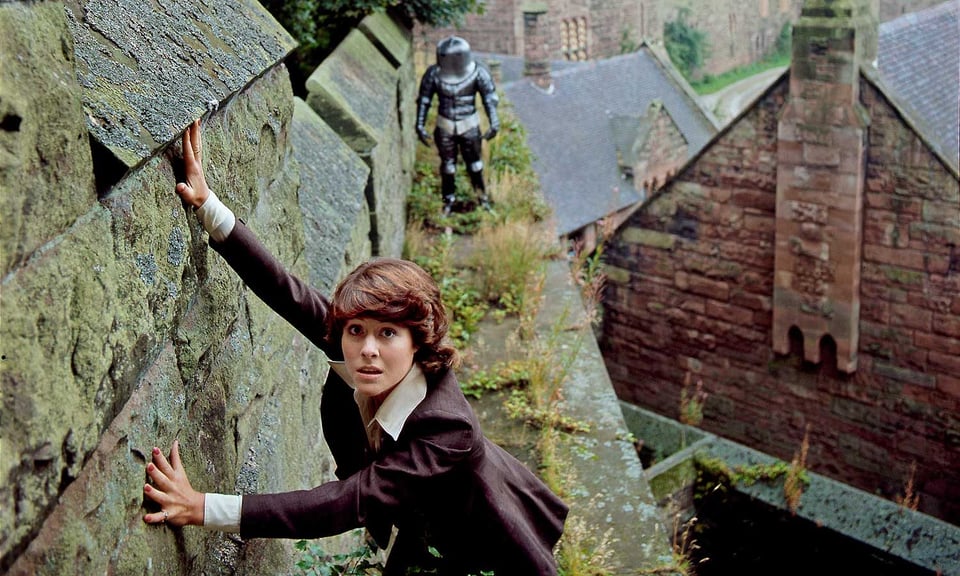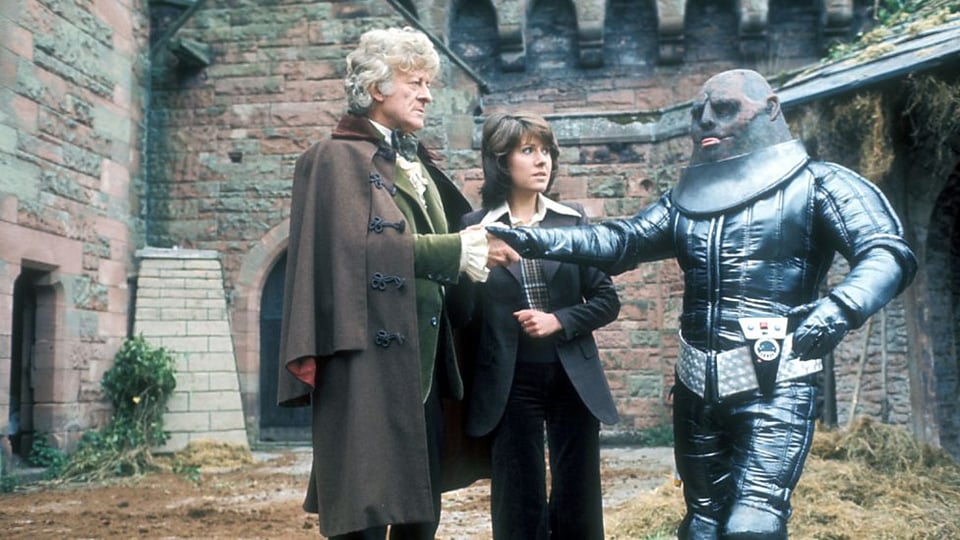The Time Warrior
Attentive readers of this newsletter, assuming it has any, will have been expecting Genesis of the Daleks next. It was, after all, on the same tape as last issue’s The Sontaran Experiment. But when posting that episode out, I tried to link to last year’s email on The Time Warrior and realised that despite being finished, it was never sent. So, here’s a Missing Episode of Psychic Paper. A blast from an imaginary past. Which is weirdly appropriate, given its content.
“Baked Potato changed my life. Baked Potato showed me the way. If you want to know what is wrong from right you must listen to what the Baked Potato say.”
The Time Warrior is one of the Doctor Who stories I first saw when renting the VHS. It is, in fact, the last of this strange and select group. I was getting a little older, and not that far away from having Saturday jobs with which to fund my burgeoning VHS collection habit. I was also moving away from wanting action figures for Christmas and Birthday presents. (I’ve since moved back). It’s a weird sort of key story for me, then. The kind of milestone you only notice long after it’s passed. Which is fitting given the nature of the serial. The Time Warrior is one of the most influential Doctor Who stories ever made, and in ways that no one could have predicted at the time.
When Doctor Who began in 1963 its production team consciously split its serials into three kinds; “past”, “future” and “sideways”. Essentially “historical fiction without SF elements other than TARDIS”, “other planets and / or monsters” and “weird”; although identifying more than a couple of stories as belonging to that third category is very difficult indeed. The barriers between the first two frayed quickly, with the middle episodes of The Chase (1965) putting Daleks on the deck of the Mary Celeste, and having them roll around a haunted house, while the next story was The Time Meddler, in which another member of the Doctor’s own race tried to change history and in which the audience were presented with a variety of thrilling anachronisms, such as gramophone in an eleventh century monastery.
In early 1966 Doctor Who suffered a catastrophic ratings crash during The Massacre a complex “past” story set in Paris in 1572, the last episode of which was seen by the smallest number of viewers for a Doctor Who episode since the week the series’ launched. It was a collapse that was, for monochrome Doctor Who, irreversible. There were around one hundred episodes of Doctor Who before The Massacre. Well over half of them were seen by 9 million people or more. After the crash, and for the rest of the 1960s, the series would only crack the 9 million barrier twice in and in one hundred and forty seven attempts.
This, and a similar (although more short-lived) crash in the series Audience Appreciation figure1 during the next “past” serial The Gunfighters two months later, led to a decision to abandon the “past” serials as originally conceived, and only two more would be made after The Gunfighters. Incoming producer Innes Lloyd talked about their unpopularity in contemporary interviews, although he said the series would continue to use “historical backgrounds” when it wanted to. In practice, it didn’t want to, and from the end of The Abominable Snowmen (1967) to late in The Time Monster (1972), no Doctor Who story is set even nominally in human history.
Early 1970s Doctor Who producer Barry Letts, who initiated The Time Warrior would claim as late as its 2007 DVD release that earlier historical stories such as The Romans had never been any good or very popular. It’s very unlikely he had either seen the serials in question or any paperwork related to their ratings and / or chart positions, and this really does feel like a kind of folk wisdom (or perhaps we should call it “fauxlore”) handed down the chain of apostolic succession inside the Doctor Who production office. Yet by his final season in charge Letts was ready to challenge it, albeit with a very large caveat.
The Time Warrior is what fans like to call a “pseudo historical”, in that it combines both period drama and science fiction elements in a single story, in the way the middle episodes of The Chase and The Evil of the Daleks (1967) had done, in which The Abominable Snowman hadn’t really and which The War Games (1969) had briefly affected to. But for the whole length of the story. It would be, rather than a stop off or an incidental detail, the bulk of the serial. Its point.
Another step on the way to The Time Warrior had been Carnival of Monsters (1973) by Robert Holmes which, possibly drawing on The War Games, has scenes with humans from Earth’s past who believe they are on their own planet and in their own native time, but who turn out to have been kidnapped by aliens with access to time travel for their own entertainment. Letts had directed Carnival of Monsters and both loved the script and was proud of the finished production. In 1981 it would be his choice for a repeat screening to represent his era as part of the The Five Faces of Doctor Who season.
Ironically, Holmes claimed to dislike Doctor Who’s historical stories, and later said he’d been dragged “kicking and screaming” into writing this one. Ironic not just in that his work on Carnival of Monsters seems to have prompted the desire for something like The Time Warrior from him, but also in that he would and thanks to it, plus Pyramids of Mars and The Talons of Weng-Chiang, become the effective architect of a sub-genre of Doctor Who that didn’t really exist until Letts told him to invent it.

Because not only is The Time Monster not like The Massacre, in that it has alien monsters in it, it isn’t like The Massacre in the way that we can say which day and date the historical events in that story take place.2 Something that really, really isn’t true of The Time Warrior, where we have trouble picking out a century with any certainty.There are a few clues concerning the generic Middle Ages of the story, but none are helpful. The robber barons mistake the word “Sontaran” for “Saracen” and say they’ve “Heard tales of their eastern magic”. But “Saracen” is evidenced as a loan world back in Old English, so that’s no help. The nobly suffering Sir Edward of Wessex talks of “interminable wars” but he could be talking any mixture of crusades or Angevin internecine squabbles.
Wessex itself is, of course, after 1066 a meaningless concept outside the novels of Thomas Hardy, but it’s pretty clear from both dialogue and costuming that this story takes places after the Norman Conquest. All this is because The Time Warrior isn’t really set in the past at all, and certainly not in real history. It’s set in a 1950s style ITC series which is itself set in a generic Middle Ages, like the one Tony Hancock wanted to make in Ericsson the Viking. History, actual history, of the kind rather important to The Massacre’s writer John Lucarotti, isn’t on the menu. The Time Warrior isn’t the story where Doctor Who remembers the TARDIS is a Time Machine. It’s the story where Doctor Who realises the extent to which the TARDIS is a machine for travelling between genres.
The 1960s “historicals”, all of which I personally broadly love, impose themselves on Doctor Who. Doctor Who becomes, for those weeks, the kind of drama the TARDIS has arrived in. From The Time Warrior onwards, Adventures in History see Doctor Who impose itself on the time period in which the TARDIS has arrived. We can’t visit an Edwardian folly or lighthouse without the arrival of an Egyptian God or a thing from another world. Renaissance Italy must be lain to siege by the alien Mandragora Helix rather than, say, Imperial Spain. The juxtaposition that has been at the heart of Doctor Who since the beginning, the one represented by the police box on the blasted heath, is finally allowed to reach its logical form. Monsters in history. Not monsters or history.
I mean, yes, The Evil of the Daleks is like this too, but coming just before the long hiatus in Doctor Who stories that even glance at the past, it’s a rather lonely outlier in the series, bordering on unique in the way The Mind Robber still is. Until The Time Warrior.
It’s not quite that cliché of “the real beginning of Doctor Who” or even “Before this story there are none like it, but after it there are many”. But, well, actually, yeah. Sorry. It is. The second one at least. Before The Time Warrior there aren’t any Doctor Who stories quite like it, and after it there are so many. Stories as recent as Rogue or Lux operate in variations of this mode.
It’s a quality common in Pertwee / Letts era stories that we don’t necessarily immediately grasp how innovative and influential they are because, and this is paradoxical, so much of later Doctor Who is in their image we can’t imagine the series not being like that, even when we watch episodes from before it was. (e.g. we do not often note that the 1970 series of Doctor Who is the first not to bring back any monsters from the 1960s and the 1971 series the second, because so much of what is offered in their place has itself become a permanent part of the series’ dramatic furniture.)
How important is The Time Warrior? Look how much I’ve written about it without even mentioning that it sees the debut of Sarah Jane Smith. The archetypal Doctor Who companion, played on television by Elisabeth Sladen in five decades and in three different television series. I’ve barely even nodded at the Sontarans, the last to debut of the old money series’ “big four monsters”3 and the most recently created of those to have been revived in the series this century.4
In fact, Sarah’s first three stories, The Time Warrior, Invasion of the Dinosaurs and Death to the Daleks offer us something like a post 2005 Doctor Who “opening trilogy”. This story’s influences are everywhere. War of the Sontarans feels like an attempt to do with this story what Aliens did with Alien. Even the title of The Time Warrior feels like it passed, consciously or otherwise, through a thought process to give us the defining event of twenty first century Doctor Who’s cosmology. For what would a Time Warrior fight but a Time War?
Linx the Sontaran may have died in the thirteenth century5 but in the battle for the future of Doctor Who, The Time Warrior won an overwhelming victory. It’s Jingo Linx’s world, we just live on it.

A mark out of 100 that represents how much the audience, regardless of size, enjoyed the programme. ↩
This is also true of e.g The Reign of Terror, The Romans, The Gunfighters, The Highlanders and even the appropriate episodes of The Chase and The Evil of the Daleks. ↩
Traditionally viewed as the Daleks (1963), the Cybermen (1966), the Ice Warriors (1967) and the Sontarans (1974). The new series has obviously added to this pantheon itself with e.g. the Weeping Angels (2007). ↩
Monsters, not villains. Sutekh is an edge case but as a “real” Egyptian God, he was created a long time before Doctor Who itself. I did spend a happy week wondering if the Tractators would be in Dot and Bubble. ↩
According to Sarah Jane in The Sontaran Experiment anyway. ↩